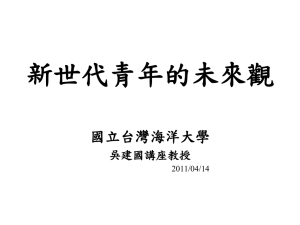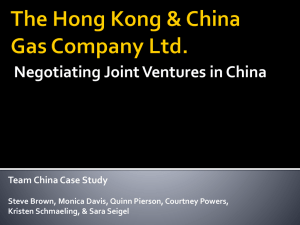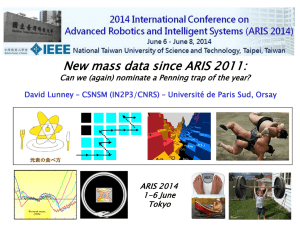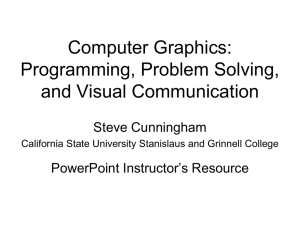Evaporation residue cross section
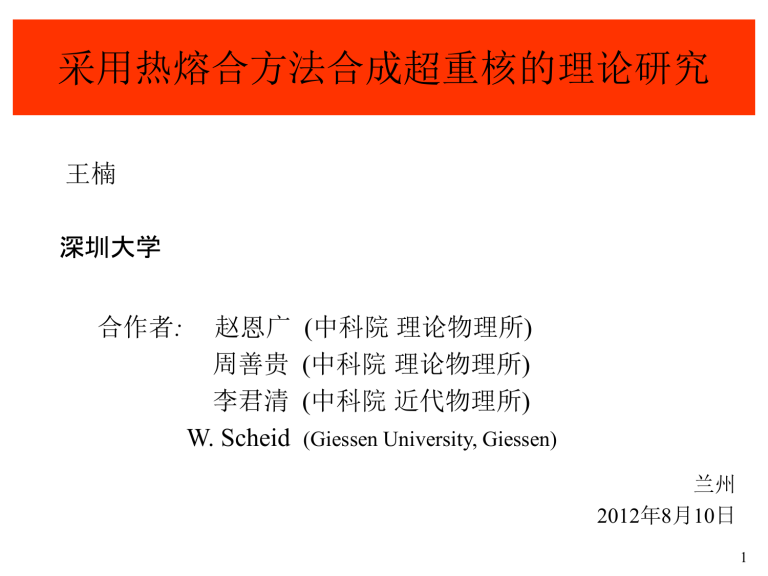
采用热熔合方法合成超重核的理论研究
王楠
深圳大学
合作者 : 赵恩广 ( 中科院 理论物理所 )
周善贵 ( 中科院 理论物理所 )
李君清 ( 中科院 近代物理所 )
W. Scheid (Giessen University, Giessen)
兰州
2012
年
8
月
10
日
1
Outline
Introduction
Theoretical Models
Results and discussions
Summary
2
Experimental achievements
Super-heavy elements up to Z=118 have been synthesized experimentally.
Z=107-113: cold fusion, 208 Pb/ 209 Bi based reactions by evaporating 1 or 2 neutrons
( Rev.Mod.Phys.72(2000)733, Rep.Prog.Phys.61(1998)639)
Z=112-118: 48 Ca induced fusion reactions, 48 Ca bombarding actinide targets by evaporating 3-5 neutrons
( J.Phys.G34(2007)R165, NPA787(2007)343c, PRC 83, 054315 (2011))
IMP in Lanzhou: 259 Db, 265 Bh, 271 Ds
3
Theoretical models for SHN production
Macroscopic dynamical model
S. Bjornholm and W.J. Swiatecki
Fusion by diffusion model
Y. Abe, Y. Aritomo , Z.H. Liu, J.D. Bao , C.W. Shen, K. Siwek-Wilczynska et al
Nucleon collectivization model
V.I. Zagrebaev
Dinuclear system model
V.V Volkov, G.G. Adamian, N.V. Antonenko, A.K. Nasirov , W. Scheid, et al
J.Q.Li, E.G. Zhao, S.G. Zhou, Z.Q. Feng, M.H.Huang, Nan Wang et al
Other model
Ning Wang
4
Schematic picture of the formation of SHN capture
T P
CF
CN fusion
EN evaporation
Evaporation residue cross section:
ER
( E c .
m .
)
2
2
E c .
m .
( 2 J
J
1 ) T ( E c .
m .
, J ) P
CN
( E c .
m .
, J ) W sur
( E c .
m .
, J )
5
Capture of two colliding nuclei
c
( E c .
m .
)
2
2
E c .
m .
J
( 2 J
1 ) T ( E c .
m .
, J )
Transmission probability calculated from barrier distribution:
T ( E c .
m .
, J )
1 f ( B )
1
exp
2
( J )
E c .
m .
B
2
2
R
B
2
( J )
J ( J
1 )
dB f ( B )
1
N
1
N exp
B
1
B m exp
B
2
B m
2
, B
2
, B
B m
B m
V.I. Zagrebaev, Phys.Rev.C 64 (2001) 034606
B m
2
(
( B
0
B
0
B s
) / 2
B s
) / 2
The value of
1 than the one of
is 2-4 MeV
2 less
6
Di-nuclear system concept
Dinuclear system concept (from the investigation of deep inelastic collisions)
V.V. Volkov, Phys. Rep. 44(1978) 93
The formation of compound nuclei is the fusion along the mass asymmetry degree of freedom.
7
Formation of compound nucleus - Master equation dP ( A
1
, E
1
, t ) dt
A
1
'
W
A
1
A
1
'
( t )[ d
A
1
P ( A
1
' , t )
d
A
1
'
P ( A
1
, t )]
qf
A
1
( t ) P ( A
1
, t )
P
CN
i
A
BG
0
P ( A i
)
Hamiltonian
H
H
0
H
0
V t
K
K
K ,
'
K
K
K
' u
K
K
'
K K a
K
K
'
K ,
'
V
KK
K
' t
8
Effects of nuclear static deformation and dynamical deformation development of dynamical deformation
Li, Wang , Li et al., J.Phys. G 32(2006) 1143
G. Wolschin, Phys.Lett.B 88 (1979) 35
C. Riedel, G.Wolschin, and W. Noerenberg,
Z. Phys. A 290, 47(1979).
9
Potential energy surface
Excitation energy of DNS
*
E
DNS
E
E total total
0
E
DNS
E c .
m .
rot
E
DNS
( M
T
M
P
) c
2
0
E
DNS
V
C
V
N
( M
1
M
2
) c
2
Potential Energy Surface(PES)
V
PES
V
C
V
N
( M
1
M
2
M
T
M
P
) c
2
Deformation dependent
Intrinsic energy
E int
( A
1
,
)
V
C
( r ,
1
,
2
)
V
N
( r ,
1
,
2
)
i
1 , 2
1
2
C i
i
2
max
( 1
e
t /
)
C
1
(
C
2
(
1
2
1
2
0
0
)
)
2
2
A
A
2
1
G. Wolschin, Phys.Lett.B 88 (1979) 35
C. Riedel, G.Wolschin, and W. Noerenberg,
Z. Phys. A 290, 47(1979).
V.I. Zagrebaev, Phys.Rev.C 64 (2001) 034606
10
Driving potential
Intrinsic energy and PES for 50 Ti+ 249 Cf
Nan Wang, En-guang Zhao, Werner Scheid and Shan-gui Zhou, Phys.Rev.C 85 (2012) 041601(R)
11
Driving potential
12
Survival probability of excited compound nucleus
The thermal compound nucleus will decay by evaporating
-ray, light particles and fission. The survival probabilities can be written as
W sur
( E
*
CN
, x , J )
P ( E
*
CN
, x , J ) x i
n
( E
, J )
( 2 s
1 )
2 m
(
R
2
E
, J )
E
*
B
n
( E i
*
,
n
J
(
)
E i
*
,
f
J )
( E i
*
, J )
i
0
E
rot
E
1 a
B
f
E 1
(
)
E rot
,
4 1
J
3
d
mc
2 e
2
c
NZ
A
G
2
G
4
E
G
2
2
2
inv
f
(
(
)
E
,
J
R
)
2
1
V
2
f
/
1
( E
, for
J for
)
E
f
V
E rot
V
0
a V
1 f
1
Z f
Z
E
Z
K
B
f
/
R
E
rot
1 .
6
exp
2
E
B f
E rot
, J
d
/
13
Results and discussions
Capture cross sections for 48 Ca + 238 U, 237 Np, 242 Pu, 244 Pu, 243 Am, 248 Cm, 249 Bk, 249 Cf
Exp. W.Q. Shen et al, PRC 88(1979) 35
M. G. Itkis, et al , Proceedings of International
Workshop on Fusion Dynamics at the Extremes,
Dubna, Russia, 2000 , (2001).
14
Potential energy surface and Pcn for 48 Ca+ 238 U, 48 Ca+ 248 Cm
15
Fusion probabilities for some hot fusion reactions
16
Survival probabilities for some compound nuclei produced in hot fusion reactions
17
Excitation functions for 48 Ca+ 238 U, 237 Np
Exp.
Yu.Ts. Oganessian, et al., PRC 70 (2004) 064609
18
Evaporation residue cross sections for 48 Ca + 242, 244 Pu
Exp.
Yu.Ts. Oganessian et al., PRC 70 (2004) 064609
P. A. Ellison, et al, PRL 105 (2010) 182701
19
Evaporation residue cross sections for 48 Ca+ 243 Am, 248 Cm
Exp.
Yu.Ts. Oganessian et al., PRC 69 (2004) 021601(R) , PRC 70 (2004) 064609
S. Hofmann, S. Heinz, R. Mann, et al.
, Euro. Phys. J. A 48, (2012) 1
20
Evaporation residue cross sections for 48 Ca + 249 Bk, 249 Cf
Exp. Yu.Ts. Oganessian et al., PRC 74.044602(2006)
PRC 83, 054315 (2011)
21
Evaporation residue cross sections for the SHN 112-120
22
Experiment about synthesis of elements 120
58 Fe + 244 Pu
Yu.Ts. Oganessian, et al., PRC 79 (2009) 024603
50 Ti + 249 Cf
C. E. Dullmann, “News from TASCA”, talk given at the 10thWorkshop on Recoil Separator for
Superheavy Element Chemistry, October 14, 2011, GSI Darmstadt, Germany (unpublished)
23
Theoretical investigations of the production of SHN 119 and 120
DNS Model
A.K.Nasirov et al. PRC 79(2009) 024606
A.K.Nasirov et al. PRC 84(2011) 044612
G.G.Adamian, G.A. Antonenko, W. Scheid. EJPA 41(2009) 235
Z.-G. Gan, et al
,
Sci. China-Phys. Mech. Astron.54 (Suppl. 1), s61 (2011)
FBD model
Z.H.Liu, J.D.Bao. PRC 84(2011) 031602(R)
K. Siwek-Wilczynska, T. Cap, M. Kowal, A. Sobiczewski, and J. Wilczynski, PRC 78(2008) 034610
V. Zagrebaev, W. Greiner PRC 78(2008) 034610
Other model
Ning Wang, J.L.Tian, W.Scheid PRC 84(2011) 061601(R)
24
25
Excitation functions for producing nuclei Z=120
Fusion probabilities as a function of excitation energy for producing nuclei Z=120
E* (MeV)
26
Evp. Cross sections for 50 Ti+
249 Bk, 54 Cr+ 243 Am and
58 Fe+ 237 Np reactions leading to nuclei with Z=119
Fusion probabilities for
50 Ti+ 249 Bk, 54 Cr+ 243 Am and
58 Fe+ 237 Np reactions leading to nuclei with Z=119
E* (MeV)
27
Excitation functions for some
Ti+ Bk, Cf isotope reactions
28
Summary
By using a newly developed dinuclear system model with a dynamical potential energy surface —the DNS-DyPES model, hot fusion reactions for synthesizing superheavy nuclei (SHN) with charge numbers
120 are studied.
Z = 112 –
Several combinations producing elements Z=119, 120 with Fe, Cr and Ti as projectile are calculated and analyzed.
The maximum ER cross section for reaction 50 Ti + 249 Bk is about 0.11pb in the 4n emission channel.
The maximum ER cross sections for reactions 50 Ti + 249 Cf and 50 Ti + 251 Cf are about 0.05pb and 0.2pb in the 3n emission channels.
29
Thanks
谢谢
30
